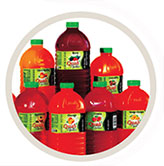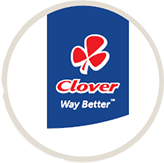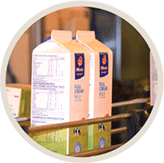Chief FINANCIAL OFFICER’S report
Overview
 |
| Jacques Botha |
High cost inflation continued into the financial year under review, with upward pressures on fuel and packaging costs exacerbated by the weaker rand.
Cost inflation could only be partially recovered through price increases during the second half of the year due to an oversupply of UHT milk in the market. The UHT market grew by 8% year-on-year, following the establishment of a number of new plants in the country which diverted drinking milk from fresh to UHT milk. The market for fresh milk correspondingly declined by 6,3%. The additional national UHT capacity saw a larger volume of peak season milk (produced in September to December) being carried forward into the second half of the year due to the long shelf life of UHT milk. This resulted in continued pressure on UHT selling prices throughout the year and Clover’s price increases during January impacted on its UHT volumes and market share.
| 2013 R’000 |
2012 R’000 |
% | |
| Revenue | 7 996 461 | 7 223 863 | 10,7 |
|---|---|---|---|
| EBITDA | 501 622 | 477 838 | 5,0 |
| EBIT | 391 388 | 371 231 | 5,4 |
| Headline EBITDA | 473 195 | 481 750 | (1.8) |
| Headline EBIT | 367 338 | 375 143 | (2,1) |
| Normalised EBITDA | 508 945 | 486 534 | 4,6 |
| Normalised EBIT | 398 711 | 379 927 | 4,9 |
| Net finance cost | 46 731 | 23 862 | 95,8 |
| Effective tax rate (%) | 30,4 | 39,6 | (23,3) |
| Headline earnings | 214 894 | 207 799 | 3,4 |
| Headline earnings per share (cents) | 119,9 | 116,0 | 3,4 |
| Diluted headline earnings per share (cents) | 111,5 | 108,7 | 2,6 |
| Normalised profit attributable to shareholders of the parent company | 237 496 | 229 493 | 3,5 |
| Normalised earnings per share (cents) | 132,5 | 128,1 | 3,4 |
| Capital expenditure: | |||
| Project Cielo Blu | 87 179 | 83 200 | 4,8 |
| Recurring capital expenditure and other projects | 367 221 | 190 482 | 92,8 |
| Return on equity (%) | 11,9 | 11,3 | 5,3 |
| Cash generated by operations | 222 195 | 416 359 | (46,6) |
| Dividends per share relating to the financial year (cents) | 32,00 | 28,4 | 12,7 |
| Notwithstanding difficult trading conditions and operational challenges, Clover managed to increase its selling prices across the board which supported the Group’s ability to exceed the results of the prior financial year despite a 33,5% decline in headline earnings reported at the interim stage. |  |
Comprehensive income
Headline earnings
The increase in headline earnings of 3,4% (R7,1 million) to R214,9 million is made up of a 2,1% reduction in headline operating profit (R7,8 million), a 95,8% (R22,9 million) increase in net finance costs, a 24,9% (R34,6 million) decrease in headline income tax and a 72,1% (R3,2 million) reduction in non-controlling interests.
Headline earnings per share increased by the same margin.
Operating profit
Gross margin decreased slightly from 27,6% to 27,0%.
Operating profit increased by 5,4% to R391,4 million. Included in operating profit are capital profits of R24,1 million of which R7,3 million are profits and losses on the sale, scrapping and impairment of assets. R16,8 million relates to a profit on the gaining of control of the Clover Manhattan joint venture. Excluding these capital profits, headline operating profit reduced by 2,1% to R367,3 million. However, the Group’s restructuring costs also increased by R26,2 million relating to the relocation of equipment that could not be capitalised and retrenchment costs as part of Project Cielo Blu. Normalised operating profit, after taking this into account, increased by 4,9% to R398,7 million.
At 4,9% the operating margin was slightly lower than the previous year’s 5,1% and the normalised operating margin was 5,0% compared to 5,3% in the previous year. During the second half of 2011/12 farm gate milk prices were increased approximately 20% and although partially reduced again early in 2012/13, the full-year effect of the increased cost could not be fully recovered from the market due to the oversupply of UHT milk in the market. This caused the operating margin to contract.
Revenue
Revenue increased by 10,7% to R7 996,5 million. Revenue from the sale of products increased by 10,8% with 4,5% coming from sales volume increases and 6,3% from selling price inflation increases.
Compared to the prior year, revenue from the rendering of services was marginally higher by 4,6%. The previous year benefitted from a specific once-off contract manufacturing arrangement. In addition, during the year under review, Clover was temporarily unable to service a contract manufacturing customer during the relocation of its UHT plant to Port Elizabeth and a contract manufacturing agreement with Foodcorp for Mageu came to an end. This resulted in a 26,2% reduction in contract manufacturing income. Income from sales, warehousing, distribution and related services increased by 11% after the inclusion of the additional Epic Foods, Red Bull and Enterprise business. After the purchase of the minority shares in Clover Manhattan this revenue however also reduced by the fees previously recovered from the Clover Manhattan minority shareholders.
Clover supplies Danone Southern Africa with the bulk of its raw milk demand. The full year effect of the considerable 2012 farm gate milk price increases and Danone’s volume growth increased this revenue by 21,4%. The sale of raw milk to Danone does not impact on profit as it is done at cost.
Cost of sales
Charges against sales was 8,9% lower than the comparative year, mostly as a result of much reduced promotional activity during the second half of the year following the Group’s selling price increases during January 2013.
The cost of raw materials increased by 11,6% due to volume growth and the knock-on effect of the high farm gate milk price increases in middle of the prior year being visible for the full 2013 financial year.
UHT packaging costs are linked to the rand/euro exchange rate. The weakening of the rand during the year combined with other oil price-linked costs and volume growth resulted in packaging costs growing by 13,2%.
During the year under review, certain costs previously allocated to milk procurement were re-allocated to production. This, together with the depreciation on new production platforms, energy cost escalation, staff cost inflation and volume growth, equated to a 12,9% increase in production costs.
Milk collection costs increased marginally by 3,7% despite steep fuel cost increases, volume growth and staff cost inflation. Overall cost increases were largely offset by savings from the renegotiated fleet services contract and the relocation of the UHT production capacity to the coast as part of Project Cielo Blu. The savings in raw milk transport costs stemming from Project Cielo Blu were as planned somewhat counter-balanced by the increased primary distribution costs.
Primary distribution is heavily impacted by fuel prices. In addition, two additional factors contributed to the above inflation increase of 16,8%, namely:
- Temporary transport of the new 18 days fresh milk from Queensburgh to Gauteng for a number of months while the Gauteng platform was being brought into operation, and
- Increased UHT volumes transported from the coastal areas to Gauteng following the relocation of the UHT plants in line with Project Cielo Blu.
Both these factors resulted in direct savings in milk collection costs as the transportation of raw milk was reduced.
Other operating income
Included in other operating income are the following extraordinary amounts:
- R11,7 million profit on sale and scrapping of assets generated mostly by the sale of the Group’s redundant Pretoria warehouse.
- R16,8 million profit on gaining control of the Clover Manhattan joint venture.
- R20,3 million foreign exchange gains on rand denominated amounts owing to Clover SA by Clover Botswana and Clover West Africa on the weakening of the rand.
Selling and distribution costs
The additional principal business of Epic Foods, Red Bull and Enterprise Foods resulted in some additional selling and distribution costs. Much higher fuel costs, high staff cost inflation, the consolidation of the RJC business together with costs associated with the launch of new products during the first half of the year inflated selling and distribution costs significantly. These cost pressures were however partly offset by the benefits associated with the renegotiated fleet services contract that came into effect on 1 July 2012.
Administrative expenses
The 6,6% increase in administrative expenditure was mainly made up by staff cost inflation .
Restructuring expenses
Project Cielo Blu required the relocation of equipment between factories and the associated costs could not be capitalised. R17,8 million was expensed in this regard and other related costs. In addition, Project Cielo Blu and the Group’s strategic exit from the majority of its bulk mozzarella business engendered R13,5 million of retrenchment costs.
Profit for the year
Profit for the year was 14,4% or R30,1 million higher at R239,9 million
Profit for the year was 14,4% or R30,1 million higher at R239,9 million after the R20,2 million increase in operating profit, a R22,9 million or 95,8% increase in net finance charges and a R32,9 million reduction in the income tax expense.
The strategic exit from the bulk mozzarella business, local and national industrial action during the first half of the year and the lower UHT sales as explained in the chief executive’s report, effectively increased the Group’s inventory levels throughout the year. These levels only started to normalise towards the end of the year and the last remnants of this inventory build-up was sold shortly after the year-end. In addition, the Group invested substantial amounts on project Cielo Blu and other capital investments during the year, including:
- The Real Juice Co. Holdings (Pty) Ltd (“RJC”) acquisition.
- The acquisition of the minority shares in Clover Manhattan.
- The individually wrapped processed cheese slices platform.
- The 18 days fresh milk technology.
- The 30 days ultra-pasteurised technology.
- The UHT prisma pack conversion.
As a result, the Group’s debt levels and finance charges increased considerably during the year.
The effective tax rate reduced from 39,6% to 30,4%, mainly attributable to large tax adjustments in the prior financial year but also partly due to a very low effective tax rate on capital profits during the reporting year.
Return on equity
The increase in the Group’s gearing and profitability improved Return on Equity to 11,9% from the 11,3% achieved in the prior year.
Dividends
The company declared and paid an interim dividend of 10c per share during April 2013. A final dividend of 22c was declared by the Board, which will bring the total dividend for the current financial year to 32c. This is 3,6c or 12,7% higher than the dividend paid in the previous financial year.
Following the settlement of preference shares during the year under review, the board believed that it was appropriate to apply a new dividend policy, details of which is set out in the Chief Executive’s report.
Financial position
Non-current assets
The increase in property, plant and equipment stems from the capital expenditure associated with Project Cielo Blu and other capital projects net of depreciation for the year.
Goodwill, trademarks and customer relationships gained on the acquisition of the RJC and the purchase of the minority shares in Clover Manhattan amounted to R83 million and contributed mainly towards the increase in Intangible Assets of R87,5 million. The balance of growth stems from investments in information technology.
 Product focusThe Clover brand
Product focusThe Clover brand
Clover, as a household name brand, has experienced steady market share over the years, however, the challenge was to increase market share in a hostile market. Gaining market share as a premium milk brand is no easy task in a market where competitors drive aggressive price strategies and consumers have become more price sensitive.
Faced with the above-mentioned business challenge Clover identified a need to reposition the brand with a stronger value proposition; create critical mass for fresh milk by developing a dairy campaign that would consolidate all dairy spend and to use communication to de-commoditise the brand.
From the key opportunities identified, Clover developed a comprehensive solution that included the creation of a new brand strategy focused around corporate identity and packaging, communications and channel positioning.
From a brand perspective the new positioning ‘Clover Way Better’ was developed in order to form the basis from which a stronger value proposition was communicated. In support of the new positioning a new Corporate Identity was developed to turn the Clover logo into a new fresh quality mark. The packaging was also redesigned to incorporate the new Corporate Identity and increase consumers’ perception around the quality of brand they were buying into.
The 360 degrees integrated campaign approach yielded phenomenal results. For the first time in over ten years Clover managed to grow the fresh milk market share from 27,2% in 2010 to 31,4% in 2012.
In addition, the media strategy consolidated all dairy media spend to support the one campaign, resulting in an integrated high-reach, high-impact campaign.
From a creative and media perspective a Millward Brown AdTrack study revealed extra-ordinary results in terms of prompted awareness, ad liking, correct recall and message take out, where the Clover Way Better brand creative performed significantly above the dairy category norms. The campaign has also received a number of prestigious international and national awards for the high calibre of work produced.
Current assets
The first half of the year saw extraordinary inventory growth as explained in the Chief Executive’s report and in the discussion on finance charges above. Inventory levels normalised towards the end of the year with most excess inventory sold shortly after the year end.
Trade receivables declined by 0,2% despite the growth in revenue. With effect from 1 June 2013 Danone Southern Africa began to take over the credit control of its major customers that were previously managed by Clover. This reduction in the debtors’ book was to some extent mitigated by the Enterprise Foods debtors’ book but is largely responsible for the reduction in trade receivables. Trade receivable days outstanding remained at very low levels. (It should be noted that trade receivable days outstanding cannot be deduced from the financial statements as the full receivables of certain distribution principals are included in trade receivables while the revenue of such principals is not included in the Statement of Comprehensive Income. Only fees earned from providing the services involved are included in revenue).
Equity
The share premium account increased by R38,2 million from the prior financial year after the settlement of vested executive management share appreciation rights by the issue of new ordinary shares.
Non-current liabilities
The preference shares were redeemed in June 2013. In addition, the last tranche of the previous debtors’ securitisation funding matured during March 2013 and the Board decided to utilise this vehicle to its full extent to take advantage of the current low interest rates. R250 million was therefore borrowed for a 3 year period at floating rates and R400 million for a 5 year period at fixed rates. Both tranches will run from 30 June 2013 and will mature on 30 June 2016 and 30 June 2018 respectively. In the 2011/12 financial statements both the preference shares and the debtors’ securitisation debt were disclosed as current liabilities.
Current liabilities
Trade and other payables decreased by R82,7 million or 6,3%.The previous year-end occurred over a weekend with certain trade creditors only paid shortly afterwards, inflating the year-end creditors’ balance. This, together with the reduction in Danone debtors, as explained above, was largely the reason for the decrease in trade payables. Principal sales are included in trade receivables, with a corresponding liability included in trade payables reflecting the amount payable to principals for their sales.
Gearing
Gearing at 30 June 2013 was 39,7% (2012: 23,4%). The Group’s gearing is well within limits as set by the Board.
Cash flow
Following the rolling of the debtors’ securitisation funding for medium term periods, the net current assets position improved from R576,4 million to R1 017,9 million. Excluding inventory, the position improved from a net current liability position of R25,6 million to net current assets of R284,5 million.
Cash generated from operations, before working capital changes, was R417,1 million compared to R444,6 million reported in the prior year. During the year under review, working capital absorbed R181,2 million of cash . The reasons for the working capital changes are discussed under current assets and liabilities above.
Investment activities consumed R516,1 million in cash. Capital expenditure on project Cielo Blu amounted to R87,2 million and capital expenditure of a recurring nature and other capital projects amounted to R367,2 million. R70,6 million was utilised to acquire the RJC and R24,7 million for the purchase of the minority shares in Clover Manhattan.
Finance costs, dividends, debt reduction and the redemption of preference shares absorbed cash of R516,1 million, of which the bulk relates to the redemption of preference shares of R259,4 million and debt repayments of R158,4 million. Further debt to the amount of R814 million was raised to fund the cash shortfall of which R650 million was raised through debtors’ securitisation and the balance from short-term bank facilities.
The Group reported a net increase in its cash position for the year of R6,6 million as a result.
Segmental performance
The segmental information is only disclosed to Margin on Materials (“MOM”) level as the Group’s assets and operations are largely integrated between segments making the allocation of overhead costs to the different segments impractical. Overheads are managed at Group level. MOM refers to revenue less raw material, ingredients and packaging costs.
Included in the dairy fluids segment is the sale of raw milk to Danone at cost. Therefore, it has no MOM impact and should be excluded from any analysis of this segment’s performance. Excluding this revenue, the MOM for fluids increased by 7,1% to R1 312,0 million. The MOM margin deteriorated by 1,1% to 38,5%, mainly resulting from the full year effect of the high 2011/2012 farmgate milk price increases. This was further exacerbated by very competitive UHT prices during the first half of the year and the high increase in UHT packaging costs. Sales volumes rose by 1,6% with fresh and ultra-pasteurised milk down 1,2% and UHT milk up 3,1%. Price inflation was 8,5% on average while the cost of materials and packaging increased by 13% net of the volume effect.
The Dairy Concentrated Products segment consists of cheese, butter, condensed milk and retail powders. Volumes decreased by 3% after the Group mostly exited the bulk mozzarella business. Pre-packed cheese volumes grew by 26,2% and feta cheese volumes by 10,4%. Segment revenue as a result grew by 3,3% based on average price inflation of 6,3% which includes the improved product mix after the strategic exit from bulk mozzarella. The price of packaging and raw materials increased by an average of 6,2% net of increased volumes. MOM improved by 8,9% and the MOM margin increased with 1,6% in line with the improved product mix.
Capital expenditure on project Cielo Blu amounted to R87,2 million and capital expenditure of a recurring nature and other capital projects amounted to R367,2 million.
 Product focus30-days shelf life ultra-pasteurised milk project
Product focus30-days shelf life ultra-pasteurised milk project
- Installed Tetra Pak VTIS steam injection technology to produce UP milk.
- By using culinary steam injection the milk is subjected to a very high temperature for a very short period of time, thereby preserving the taste of the milk.
- Installed Galdi 2L ESL gable top carton filling line with proprietary ESL milk delivery system to feed the filler.
- Plant is capable of producing 15 000 litres/hour of UP milk.
- Created 12 additional jobs.
International dairy ingredient prices remained robust throughout the year and peaked at record high prices during April 2013. As previously mentioned and as discussed in the Chief Executive’s report, Clover was required to convert a much higher volume of milk into milk powder during the 2012 peak production season. The Group managed to find a market for its excess powder, albeit at prices notably lower than the ruling international prices. Clover only accesses international dairy commodity markets occasionally and is not in a position to command the same prices as other regular international dairy exporters. The Group’s exposure to the ingredients segment is largely confined to its joint venture, Clover Fonterra Ingredients. This company normally procures most of its products from the international markets. Volumes grew by 3,1%.
Revenue however declined by 3,5% due to the discounted selling prices of Clover produced powder and the quantum of this powder in the overall product mix. MOM grew by 7,1% and the MOM margin improved from 19,6% to 21,7% on the back of lower cost prices of the same locally manufactured powder.
MOM from the beverages segment showed a very healthy 22,5% growth to R986,9 million. Volume growth was 15,4% which, combined with price inflation of 5,9% resulted in a 21,2% increase in segment revenue to R1 888,2 million. The acquisition of RJC with effect from October 2012 contributed 7,7% to volume growth and the MOM margin increased by 0,5% to 52,3%.

Jacques Botha
Chief Financial Officer
11 September 2013

